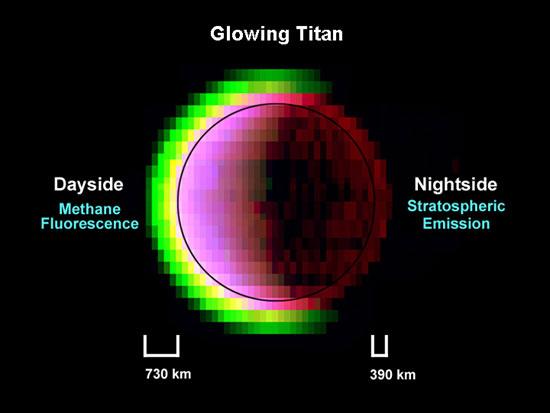Glowing Titan

| PIA Number | PIA06419 |
|---|---|
| Language |
|
Glowing Titan August 5, 2004 | |
The glow of Titan's extensive atmosphere shines in false colors in this view of Saturn's gas-enshrouded moon acquired by the Cassini spacecraft visual and infrared mapping spectrometer during the July 2, 2004, flyby. This image is a combination of near-infrared colors, each of which probes different phenomena in the moon. | |
On the nightside (right side), the moon glows red out for over 200 kilometers (125 miles) altitude, indicating carbon-monoxide emission at 4.7 micron wavelength produced in Titan's relatively warm stratosphere. This glow actually extends over the dayside as well, producing the yellow layer observed on the left as the two glows from methane (green) and carbon monoxide (red) mix together in this rendition. Titan's surface is indicated by the circle determined by a surface image at 2.0 microns (blue), which is unaffected by atmospheric glows showing the sunlit surface. Here, due to the reddish glow of carbon monoxide overlying the blue-colored surface, most of the dayside appears purplish in color.
The Cassini-Huygens mission is a cooperative project of NASA, the European Space Agency and the Italian Space Agency. The Jet Propulsion Laboratory, a division of the California Institute of Technology in Pasadena, manages the Cassini-Huygens mission for NASA's Science Mission Directorate, Washington, D.C. The Cassini orbiter was designed, developed and assembled at JPL. The visible and infrared mapping spectrometer team is based at the University of Arizona, Tucson.
For more information about the Cassini-Huygens mission visit, http://saturn.jpl.nasa.gov. For more information about the visual and infrared mapping spectrometer visit http://wwwvims.lpl.arizona.edu.
Image Credit:
NASA/JPL/University of Arizona
